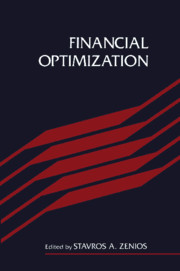Book contents
- Frontmatter
- Contents
- List of contributors
- Foreword
- Preface
- Acknowledgments
- Part I General overview
- Part II Models
- 5 An economic approach to valuation of single premium deferred annuities
- Commentary by D.F. Babbel
- 6 The optimal portfolio system: targeting horizon total returns under varying interest-rate scenarios
- 7 Optimization tools for the financial manager's desk
- 8 A flexible approach to interest-rate risk management
- 9 Currency hedging strategies for US investment in Japan and Japanese investment in the US
- Commentary by Y. Beppu
- Part III Methodologies
- Index
Commentary by Y. Beppu
Published online by Cambridge University Press: 09 February 2010
- Frontmatter
- Contents
- List of contributors
- Foreword
- Preface
- Acknowledgments
- Part I General overview
- Part II Models
- 5 An economic approach to valuation of single premium deferred annuities
- Commentary by D.F. Babbel
- 6 The optimal portfolio system: targeting horizon total returns under varying interest-rate scenarios
- 7 Optimization tools for the financial manager's desk
- 8 A flexible approach to interest-rate risk management
- 9 Currency hedging strategies for US investment in Japan and Japanese investment in the US
- Commentary by Y. Beppu
- Part III Methodologies
- Index
Summary
Among world equity markets, the largest is the Tokyo Stock Exchange, the second is the New York Stock Exchange, the third is the US NASDAQ market, and the fourth will be the JASDAQ market which Japan is going to organize and start in 1992, exploring the possibility of connecting computers with NASDAQ. In recent years, therefore, Japanese investment in the US and American investment in Japan have been important activities in rapidly integrating world capital markets. Professor William T. Ziemba presented a timely and significant study, entitled "Currency Hedging Strategies" at the Conference on Financial Optimization held at The Wharton School of the University of Pennsylvania on 10 November 1989. His principal conclusion is as follows:
For the American investing in Japan, the hedge provides a substantial bonus: an essentially risk free gain of about 3-5% per year due to the difference in interest rates between the two countries. … The situation is much more difficult and complicated for Japanese investment in the US. The forward/futures hedge will eliminate the currency risk but at a cost of about 3-5% per year.
In his chapter, he explored mainly the latter case, upon which I will comment.
- Type
- Chapter
- Information
- Financial Optimization , pp. 236 - 240Publisher: Cambridge University PressPrint publication year: 1993



